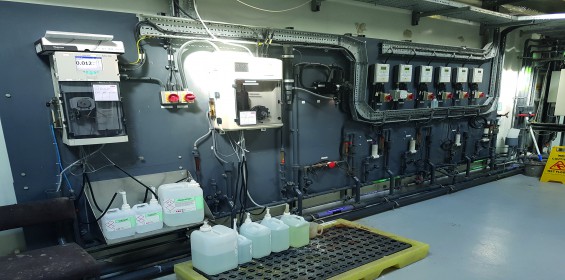Keeping continuous water quality analysers functioning
Published: 07 June, 2019
Mike Sparrey, water & utilities sales manager for ABB measurement & analytics in the UK, puts forward some tips for looking after water quality instruments that can help to minimise potential problems and extend service life.
As the front line in any water quality measurement scheme, continuous water quality analysers need to be kept in good working order to provide accurate, reliable and repeatable performance.
Tightening environmental legislation, coupled with customer expectations of quality and availability are seeing continuous water analysers being used to measure an extensive range of parameters, from dissolved oxygen in aeration processes through to chlorine and turbidity.
Capable of taking ongoing readings which can be automatically relayed to a central monitoring system, continuous water analysers help to eliminate the delays and added uncertainties associated with extractive testing methods.
Despite their advantages, however, the performance of continuous water analysers is only as good as the condition of the analyser itself.
With the introduction of ever more stringent standards by the UK Environment Agency, it is particularly important to maintain analysers to the highest possible levels as a matter of best practice. In the event of a water quality incident occurring, operators must demonstrate that their monitoring and measurement equipment was being correctly maintained in accordance with recognised best practice.
The following provides some recommendations for measures that can be put in place to help ensure continued effectiveness.
Initial warning signs
Many of the latest generation of analysers incorporate self-diagnostic features and alarm capabilities to warn when something is wrong. Although these signals are useful in determining when maintenance needs to be performed, it is nevertheless advisable to have a preventive maintenance regime in place to help extend the life of the instrument.
Check reagent levels
Reagents are crucial for producing the chemical reaction needed for an accurate measurement to take place. As such, it is important to ensure that reagents are replenished as soon as they are exhausted. Checking reagent consumption regularly will help you predict the best time to carry out a changeover. As reagents have a shelf life, check the expiration date before exchanging the used reagent with the new one. In addition, regular maintenance will also help to show whether the reagent is being consumed at the rate that should be expected for the application. Under or over consumption can be indicative of a problem in the analyser’s fluid handling system, such as a blockage or restriction.
Perform regular visual checks
Analyser functions and readings should be thoroughly checked to ensure they work at optimum efficiency. Checking for leaks (pipe connections and tubing and liquid handling components), liquid levels (reagents, calibration and cleaning solution bottles) and potential obstructions to the sample flow should be performed as regularly as possible.
It’s also worth remembering that erratic readings on the analyser display unit may not be indicative of a fault with the transmitter, but rather external factors such as unexpected changes in water quality. Where doubts arise, it is advisable to check the analyser’s historical log to compare the period during which erratic readings took place against the known operating conditions. In addition, always check the analyser’s high and low measured values. Any discrepancies in the measured values may be symptomatic of a number of potential issues. These could include incorrect calibration or variations in ambient temperature and humidity conditions that could be affecting the sample. If a filter is fitted prior to the analyser, there is also the possibility that some important parameters may be being filtered out.
Check calibration
Ensuring that your analyser is properly calibrated will have a material impact on its ability to deliver continued measurement accuracy. Errors can arise when changing reagents, with potential failures arising if the reagents are not fitted properly, if tubing is blocked or restricted or if the reagent lines were not properly primed. Failure of a routine calibration can also be symptomatic of issues within the analyser, such as blocked tubes and valves, leaking seals or contamination of the reference standard.
Check the sensor
It is worth checking analyser systems that are in direct contact with the process, as sensors can become obstructed or damaged as they often bear the brunt of any adverse conditions. In waste water treatment processes in particular, sensors can quickly become fouled by the build-up of organic matter or subjected to abrasion by sediment. The accuracy of electrochemical sensors used in dissolved oxygen monitoring applications, for example, can quickly become impaired due to fouling of the sensor membrane.
Replacement of components
Follow the manufacturer’s recommendations regarding the replacement of any key components. Depending on the type of analyser being used and its application, consider changing parts such as tubing, measurement cells and seals and diaphragms on a yearly or bi-annual basis.
Recommended frequency
Given the diverse range of parameters that are measured in water and waste treatment processes, it is difficult to set a universal rule when it comes to setting the frequency of maintenance checks. In most cases, it is possible to create a maintenance routine by monitoring the nature of past breakdowns with any issues that have been recorded, such as fouling, abrasion or measurement variations. By using these as a guideline, it will then be possible to create a maintenance routine that can help to safeguard against future occurrences. In addition, information from the device manufacturer should also be taken into account in order to further optimise performance.
Consider the lifecycle
Another factor that can affect the way that an analyser is maintained is where it sits in its lifecycle. This should take into account the model, age and make of the analyser. Models that are at the start of their product lifecycle will be well-supported, with ready spares availability. This may differ for models from older product ranges, where spares and the expertise to service them may not be as readily available. Dealing with reputable manufacturers can help to minimise this, as they are more likely to be able to support older products or else to recommend a suitable upgrade path with an alternative replacement.
The important role played by continuous water quality analysers in safeguarding the quality of both potable and treated waste water makes it critical to ensure they are kept in top working order. With water quality analysers being very much on the front line of every water treatment process, the need to ensure they are kept in good working order is of paramount importance in order to avoid any penalties arising from a failure.
Following the steps outlined in this article will provide a useful starting point for helping to design an effective maintenance strategy and prolong the life of continuous water analysers.






 ADEPT PURE WATER, a specialist in water purification equipment, reports it has supplied a reverse osmosis plant to Brompton Bicycle, the folding bike manufacturer. The high quality finish on Brompton’s bikes is the result of corrosion resistant powder coating. “We are looking to meet at least 1000 hours in salt spray testing”, says factory manager Tony Hobbs, “and that means that surface preparation is absolutely critical. The best way of achieving high quality surface is by using pure water.”
ADEPT PURE WATER, a specialist in water purification equipment, reports it has supplied a reverse osmosis plant to Brompton Bicycle, the folding bike manufacturer. The high quality finish on Brompton’s bikes is the result of corrosion resistant powder coating. “We are looking to meet at least 1000 hours in salt spray testing”, says factory manager Tony Hobbs, “and that means that surface preparation is absolutely critical. The best way of achieving high quality surface is by using pure water.”
